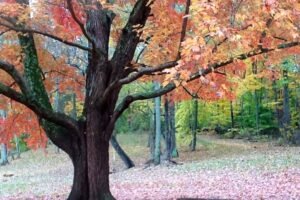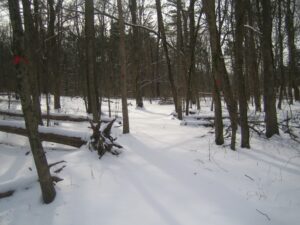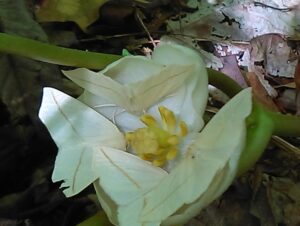By Wren Smith
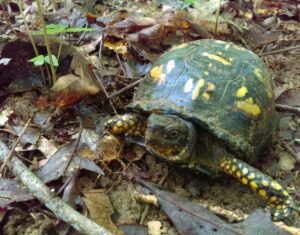 My year of writing this blog is ending. It’s been a wonderful journey, providing me the opportunity to slow down, pay attention, and share with you some of my discoveries on this one small wooded trail. If you have joined me
My year of writing this blog is ending. It’s been a wonderful journey, providing me the opportunity to slow down, pay attention, and share with you some of my discoveries on this one small wooded trail. If you have joined me  on this journey, along the way we have witnessed the turning of the great wheel, the ripening to fullness of late summer, as the spicebush berries turned from green to red. We’ve taken time to enjoy the bracing fragrance of their leaves, twigs, and berries. I contemplated the loss of a dear friend, Laurie Davison upon encountering a fallen giant along this trail, and shared how our perceptions are framed by life occurrences. It is true that ” you can’t step in the same river (or woods) twice.”
on this journey, along the way we have witnessed the turning of the great wheel, the ripening to fullness of late summer, as the spicebush berries turned from green to red. We’ve taken time to enjoy the bracing fragrance of their leaves, twigs, and berries. I contemplated the loss of a dear friend, Laurie Davison upon encountering a fallen giant along this trail, and shared how our perceptions are framed by life occurrences. It is true that ” you can’t step in the same river (or woods) twice.”
We explored the mystery and history of the white snakeroot and its connection with the death of Abraham Lincoln’s mother. We pondered the possible difference this death had on the course of our nation’s history.
We savored the gifts of autumn with its changing color palette and the whirling of leaves that opened the woods to light while carpeting our wanderings. We paused in the pawpaw patch, and sang a little tune. We saluted persimmons, hackberries, hickory nuts; while marveling at the exquisite timing of such food for wildlife; timing that is sadly altered by climate change.
We’ve taken time to listen to the silence of the winter woods, and the music of a trickling stream, as we reflected on the value of water.

We identified trees by their bark and watched winter buds swell before the advent of spring.
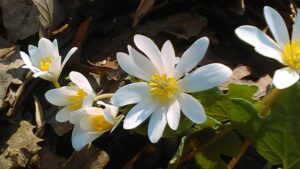 We celebrated spring by noticing the wave of woodland wildflowers, such as toothworts, trout lilies, bloodroot, and so many more, while investigating stories hidden in their names.
We celebrated spring by noticing the wave of woodland wildflowers, such as toothworts, trout lilies, bloodroot, and so many more, while investigating stories hidden in their names.
We discovered the mysterious white slant-winged moths tucked away in the blossoms of mayapples.
We delighted in the return of the migrating warblers, and other birds, as the woods filled with the sound of music.



How fitting that on my last hike for my last post in this series, I found an Eastern box turtle – Terrapene Carolina Carolina lumbering along the trail. I’ve always been fond of box turtles. I admire their ancient linage, their ability to plod along, and their closeness to the earth. They never seem to be in a hurry, even if they are. They give the impression that rushing around isn’t necessary or wise. They keep their cool. However, if threatened, box turtles retreat inside their armed fortress. Turtle shells are made primarily of bone, covered by a thin layer of fingernail-like material known as keratin. Box turtle takes this protection a step further than most turtles. They have a special feature, a hinged plastron (the bottom portion of the shell)that allows them to shut the door once they’ve tucked themselves inside. This particular box turtle was a female. Male box turtles have a concave plastron, the female does not. The concave plastron helps the male mount the female during mating. Male box turtles usually have red eyes and the females brown eyes. If you find a box turtle with reddish brown eyes you can check the plastron to make the gender determination. Although such things are of much more importance to the turtles, one of the disadvantages of being a box turtle must be the infrequency of encountering the opposite sex. Over their long evolution, box turtles (and other turtles) have solved that problem. The females can store sperm for up to four years from one mating. This seems a solid response to what can be a long stretch of celibacy.
Habitat loss, fragmentation, and roads are taking their toll on turtles. While I don’t recommend wild swerving to avoid hitting them, looking ahead for rounded objects on the road to avoid may help them continue on their slow and steady journey.
The box turtle can remind us that it’s good to sometimes slow down, take our time, and remember there is no rush. The journey is what we have. It’s all we have.
I’d like to thank all who’ve joined me on this journey. I hope it has provided a lens into different stories within Bernheim, and perhaps your own neighborhood. If you are new to the series you can visit past posts in our archives. Replacing Tales from the Bent Twig Trail you’ll find weekly posts in our new series, the Nature Notebook. I will contribute a post each month to this new series, but most of the writing will come from some of our wonderful team of Volunteer Naturalists. I’m looking forward to the new journey, please join us!

Want more Tales from Bent Twig? Click here to view the archive.



